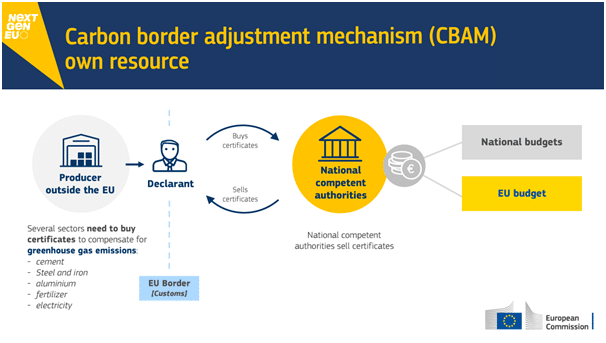What is the EU’s carbon border adjustment mechanism?
Context: Recently, co-legislators at the European Commission signed the Carbon Border Adjustment Mechanism (CBAM). It has been described as a “landmark tool” to put a “fair price on the carbon emitted during the production of carbon intensive goods that are entering the EU, and to encourage cleaner industrial production in non-EU countries.
What is the CBAM?
- It refers to a phenomenon where a EU manufacturer moves carbon-intensive production to countries outside the region with less stringent climate policies. In other words, replace EU-manufactured products with more carbon-intensive imports.
- From 2026, once the CBAM is fully implemented, importers in the EU would have to buy carbon certificates corresponding to the payable carbon price of the import had the product been produced in the continent, under its carbon pricing rules.
- Contrarily, if a non-EU producer is paying a price (or tax) for carbon used to produce the imported goods, back home or in some other country, the corresponding cost would be deducted for the EU importer.
- The Commission, in coordination with relevant authorities of the member states, would be responsible for reviewing and verifying declarations as well as managing the central platform for the sale of CBAM certificates.
- Importers would have to annually declare by May-end the quantity and embedded emissions in the goods imported into the region in the preceding year.
- The idea here is to avert the possibility of carbon leakage alongside encouraging producers in non-EU countries to green their manufacturing processes.
- Moreover, it will ensure a level playing field between imports and EU products. This would also form part of the continent’s broader European Green Deal which endeavours to achieve 55% reduction in carbon emissions compared to 1990 levels by 2030 and become a climate neutral continent by 2050.
Why are countries worried?
- CBAM would initially apply to imports of certain goods and selected precursors, whose production is carbon-intensive and are at risk of ‘leakage’ such as the cement, iron and steel, aluminium, fertilizers, electricity and hydrogen sectors.
- In 2021, the United Nations Conference on Trade and Development (UNCTAD) had concluded that Russia, China and Turkey were most exposed to the mechanism. Considering the level of exports to the union in these sectors, it stated India, Brazil and South Africa would be most affected among the developing countries.
- Mozambique would be the most exposed least-developing country. Important to note, countries in the EU combined represent about 14% of India’s export mix for all products, steel and aluminium included.
- India’s exports in the five segments represented less than 2% of the total exports to the EU between 2019 and 2021.
- However, according to Ms. Jaspal, while the impact of the regulation may appear limiting, its long-term effects can be severe for multiple factors.
- First, EU being India’s third largest trade partner and given the latter’s projected growth trajectories, the size of exports (including in the CBAM sectors) will invariably rise.
- Secondly, CBAM’s scope would expand beyond its current ambit to include other sectors as well. “Given India’s products have a higher carbon intensity than its European counterparts, the carbon tariffs imposed will be proportionally higher making Indian exports substantially uncompetitive.
- Finally, international climate policies (including CBAM) will compel other countries to impose similar regulation eventually translating to “a significant impact” on India’s trading relationships and balance of payments.
| Practice Question
1. What is Carbon Border Adjustment Mechanism? Why it is facing backlash outside Europe? |




